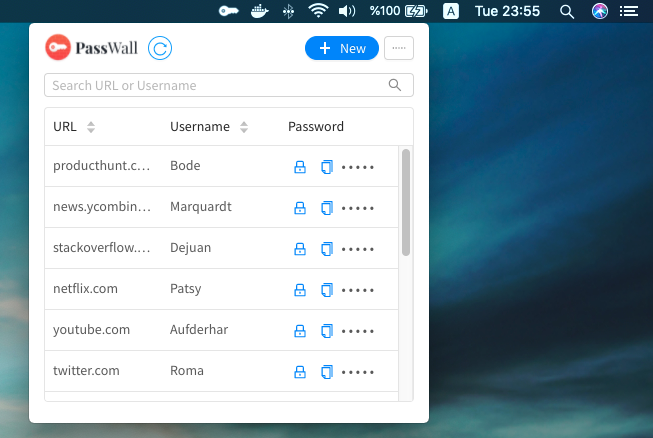PassWall Server
PassWall Server is the core backend for open source password manager PassWall platform. Using this server, you can safely store your passwords and access them from anywhere.






Support
I promise all the coffee you have ordered will be spent on this project

Clients
PassWall can be used by these clients or you can write your own client by using API Documentation
PassWall Web
PassWall Desktop
PassWall Mobile
The screenshot of Passwall Desktop working with Passwall Server is as follows

API Documentation
API documentation available at:
Click to see at Public Postman
DEMO
Address: https://passwall-server.herokuapp.com
Username: passwall
Password: password
Database supoort
PassWall works with PostgreSQL databases. Settings required for connection to database are in ./store/config.yml.
What's possible with PassWall Server?
Currently, this project is focused on storing URL, username and password which is basically called Login at PassWall.
An admin can;
- View and search logins
- Create login with automatically generated strong password
- Update login
- Delete login
- Import logins from other password managers
- Export logins as CSV format
Authentication and Security
This server uses JWT Token to secure endpoints. So user must generate token with /auth/signin first. Then with generated token, all endpoints in API documentation can be reachable.
User information for signin is in config.yml file.
Security
-
PassWall uses The Advanced Encryption Standard (AES) encryption algorithm with Galois/Counter Mode (GCM) symmetric-key cryptographic mode. Passwords encrypted with AES can only be decrypted with the passphrase defined in the config.yml file.
-
Endpoints are protected with security middlewares against attacks like XSS.
-
Against SQL injection, PassWall uses Gorm package to handle database queries which clears all queries.
-
There is rate limiter for signin attempts against brute force attacks.
Environment Variables
These environment variables are accepted:
Server Variables:
- PORT
- PW_SERVER_USERNAME
- PW_SERVER_PASSWORD
- PW_SERVER_PASSPHRASE
- PW_SERVER_SECRET
- PW_SERVER_TIMEOUT
- PW_SERVER_GENERATED_PASSWORD_LENGTH
- PW_SERVER_ACCESS_TOKEN_EXPIRE_DURATION
- PW_SERVER_REFRESH_TOKEN_EXPIRE_DURATION
Database Variables
- PW_DB_NAME
- PW_DB_USERNAME
- PW_DB_PASSWORD
- PW_DB_HOST
- PW_DB_PORT
- PW_DB_LOG_MODE
Backup Variables
- PW_BACKUP_FOLDER
- PW_BACKUP_ROTATION
- PW_BACKUP_PERIOD
Development usage
Install Go to your computer. Pull the server repo. Execute the command in server folder.
go run ./cmd/passwall-server/main.go
The server uses config file end environment variables. If you want to set variables manually, just change config-sample.yml to config.yml in store folder.
Docker
docker-compose up --build
or in project folder
docker pull passwall/passwall-server
cp ./store/config-sample.yml ./store/config.yml
docker run --name passwall-server --rm -v $(pwd)/store:/app/store -p 3625:3625 passwall/passwall-server
Import
There are different kinds of password managers. Almost all of them can export login information as CSV file. Here is an example CSV file (let's say example.csv).

You need to fill the import form as below picture.

Hello Contributors
-
Don't send too much commit at once. It will be easier for us to do a code review.
-
Be sure to take a look at the dev branch. The version I am working on is there.
-
First try to fix // TODO:s in the code.
-
Then you can contribute to the development by following the mile stones.
-
Don't mess with the user interface. The design guide has not been released yet.